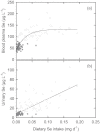Soil-type influences human selenium status and underlies widespread selenium deficiency risks in Malawi
- PMID: 23478344
- PMCID: PMC3594796
- DOI: 10.1038/srep01425
Soil-type influences human selenium status and underlies widespread selenium deficiency risks in Malawi
Abstract
Selenium (Se) is an essential human micronutrient with critical roles in immune functioning and antioxidant defence. Estimates of dietary Se intakes and status are scarce for Africa although crop surveys indicate deficiency is probably widespread in Malawi. Here we show that Se deficiency is likely endemic in Malawi based on the Se status of adults consuming food from contrasting soil types. These data are consistent with food balance sheets and composition tables revealing that >80% of the Malawi population is at risk of dietary Se inadequacy. Risk of dietary Se inadequacy is >60% in seven other countries in Southern Africa, and 22% across Africa as a whole. Given that most Malawi soils cannot supply sufficient Se to crops for adequate human nutrition, the cost and benefits of interventions to alleviate Se deficiency should be determined; for example, Se-enriched nitrogen fertilisers could be adopted as in Finland.
Figures




References
-
- Fairweather-Tait S. J. et al. Selenium in human health and disease. Antioxid. Redox Signal. 14, 1337–1383 (2011). - PubMed
-
- Kryukov G. V. et al. Characterization of mammalian selenoproteomes. Science 300, 1439–1443 (2003). - PubMed
-
- Benemariya H., Robberecht H. & Deelstra H. Daily dietary intake of copper, zinc and selenium by different population groups in Burundi, Africa. Sci. Total Environ. 136, 49–76 (1993). - PubMed
Publication types
MeSH terms
Substances
LinkOut - more resources
Full Text Sources
Other Literature Sources

